Investigation of probabilities of formation and decay of superheavy systems in in the vicinity of the “island of stability”
News, 12 August 2021
The group of authors including E. M. Kozulin, A. A. Bogachev, I. V. Vorobiev, M. G. Itkis, J. M. Itkis, G. N. Knyazheva, D. Kumar, K. V. Novikov, A. N. Pan, I. V. Pchelincev was awarded the First JINR Prize 2020 in the category “Experimental Physics Research” for the paper “Investigation of probabilities of formation and decay of superheavy systems in dependence on the Coulomb factor Z1Z2 at energies near the Coulomb barrier”.
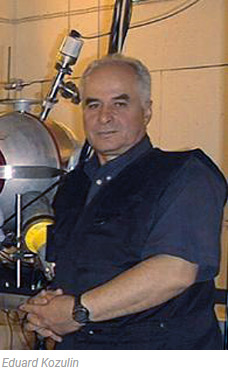 Production of nuclei in the vicinity of the “island of stability” and investigation of their properties is one of the major goals of modern nuclear physics. According to theoretical predictions, the “island of stability” is expected near the neutron shell at N = 184 and proton shells at Z = 114 or Z = 120–126. The proton closed shell number has not yet been established unequivocally since theoretical models give different predictions and strongly depend on the choice of the parameters for nucleon-nucleon interactions in the nucleus. The available experimental data confirm the existence of the “island of stability” but have not yet allowed defining these numbers.
Production of nuclei in the vicinity of the “island of stability” and investigation of their properties is one of the major goals of modern nuclear physics. According to theoretical predictions, the “island of stability” is expected near the neutron shell at N = 184 and proton shells at Z = 114 or Z = 120–126. The proton closed shell number has not yet been established unequivocally since theoretical models give different predictions and strongly depend on the choice of the parameters for nucleon-nucleon interactions in the nucleus. The available experimental data confirm the existence of the “island of stability” but have not yet allowed defining these numbers.
Recently great success has been achieved in the synthesis of new superheavy elements formed in complete fusion of heavy nuclei. At present, both cold (where one of the reaction partners is 208Pb or 209Bi) and hot (using 48Ca ions) fusion reactions have been used for their production. The hot fusion reactions of actinide targets with 48Ca ions allow producing compound nuclei with relatively low excitation (30–40 MeV) at the interaction energies near the Coulomb barrier. Moreover, the neutron excess of 48Ca allows obtaining more neutron-rich nuclei than in the case of the cold fusion reactions. The formation cross sections of new superheavy elements with Z = 112–118 obtained in the reactions with 48Ca ions are of the order of a few picobarns [1–4], while in the cold fusion reactions the cross sections drop rapidly with increasing element number, and the cross section for Nh (Z = 113) is about 55 fb [5]. Further progress in synthesis of new superheavy using cold fusion reactions is hindered due to this dramatic decrease of the formation cross sections.
The heaviest element known today is Oganesson (294Og) with Z = 118 produced in the complete fusion reaction 48Ca + 249Cf. The production of superheavy elements with Z > 118 and the investigation of their properties is of particular interest in studying the “island of stability”. Unfortunately, these nuclei cannot be synthesized in 48Ca-induced reactions since 249Cf is the heaviest target material available for these purposes. A possible alternative pathway is represented by the complete fusion of actinide nuclei with heavier projectiles such as Ti, Cr, Fe, or Ni.
However, an increase of the Coulomb repulsion between the interacting nuclei (Z1Z2) results in decrease of compound nucleus formation cross section. The Coulomb factor is one of the key parameters that determine the interaction mechanism of two massive nuclei (compound nucleus formation, quasifission or deep inelastic collisions). Quasifission and deep inelastic collisions are considered binary multinucleon transfer reactions with a full momentum transfer in which the composite system separates after the capture in two main fragments without forming a compound nucleus. Quasifission happens to be the most important mechanism that prevents the formation of superheavy elements in the fusion of heavy nuclei.
To investigate the probability of formation and decay of superheavy systems in the vicinity of the “island of stability” in dependence on the Coulomb factor Z1Z2 we conducted a series of experiments to measure the mass, energy and angular distributions of binary fragments formed in the 52Cr + 232Th, 52,54Cr + 248Cm, 86Kr + 198Pt, and 68Zn + 232Th reactions leading to the formation of the superheavy composite systems with Z = 114 and 120.
A comparative analysis performed in the papers presented for the competition [6–9] with the results obtained earlier for the reactions with 36S, 40,48Ca, 48,50Ti, 58Fe, and 64Ni ions allowed us to evaluate fusion probabilities in the wide range of Coulomb factor Z1Z2 from 1472 to 2808. The measurements were carried out at the Flerov Laboratory of Nuclear Reactions, Dubna, and the Physics Department of the Jyväskylä University, Finland, using the double-arm time-of-flight spectrometer CORSET [10].
The investigations [6, 8] showed that in the case of the reactions with 48Ti and 52,54Cr ions the properties of asymmetric quasifission fragments are similar to those obtained in the reactions with 48Ca ions with the reaction time of about 5–7×10-21s (see Fig. 1). However, shorter reaction times of about 3×10-21 s were observed in the case of Ni and Zn ions, probably, due to the strong Coulomb repulsion between interacting nuclei, which leads to the rather quick decay of the formed dinuclear system.
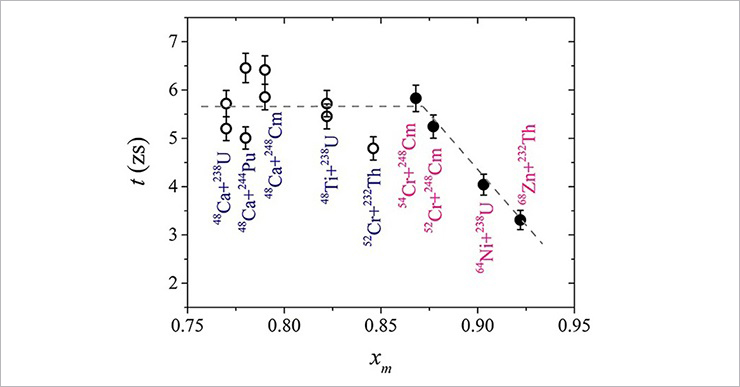 Fig. 1. The estimated time for asymmetric quasifission processes for the studied reactions in comparison with those obtained for the reactions of 48Ca and 48Ti ions with actinide nuclei as a function of the mean fissility parameter. The dashed lines guide the eye.
Fig. 1. The estimated time for asymmetric quasifission processes for the studied reactions in comparison with those obtained for the reactions of 48Ca and 48Ti ions with actinide nuclei as a function of the mean fissility parameter. The dashed lines guide the eye.
From the comparison of mass and energy distributions and capture cross sections, it was found that the contribution of quasifission fragments formed in long-lived composite systems decreases sharply at the transition from systems with Z1Z2 ≈ 2300 (52Cr + 232Th, 52,54Cr + 248Cm) to those with Z1Z2 > 2500 (86Kr + 198Pt, 68Zn + 232Th), and the main reaction channels were shown to be a few-nucleon transfer and deep inelastic collisions.
Mass-total kinetic energy distributions of the binary fragments obtained in the studied reactions are shown in Figures 2 and 3. The fissionlike products within the contour lines are characterized by large mass transfer and energy dissipation and can originate either from compound-nucleus fission or quasifission processes. It should be noted that the fission and quasifission fragments have similar properties that makes difficult to separate them.
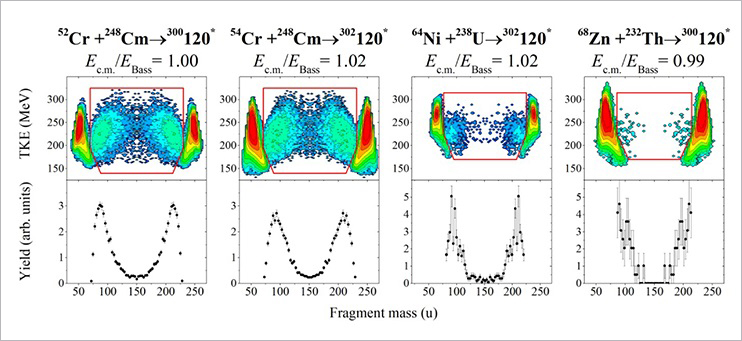 Fig. 2. The mass and energy distributions of binary fragments formed in the reactions 52,54Cr + 248Cm, 64Ni + 238U, and 68Zn + 232Th leading to the formation of composite systems with Z = 120 at energies near the Coulomb barrier. Top panels: M-TKE matrices of binary reaction products. Bottom panels: mass distributions of fissionlike fragments inside the polygons in M-TKE matrices.
Fig. 2. The mass and energy distributions of binary fragments formed in the reactions 52,54Cr + 248Cm, 64Ni + 238U, and 68Zn + 232Th leading to the formation of composite systems with Z = 120 at energies near the Coulomb barrier. Top panels: M-TKE matrices of binary reaction products. Bottom panels: mass distributions of fissionlike fragments inside the polygons in M-TKE matrices.
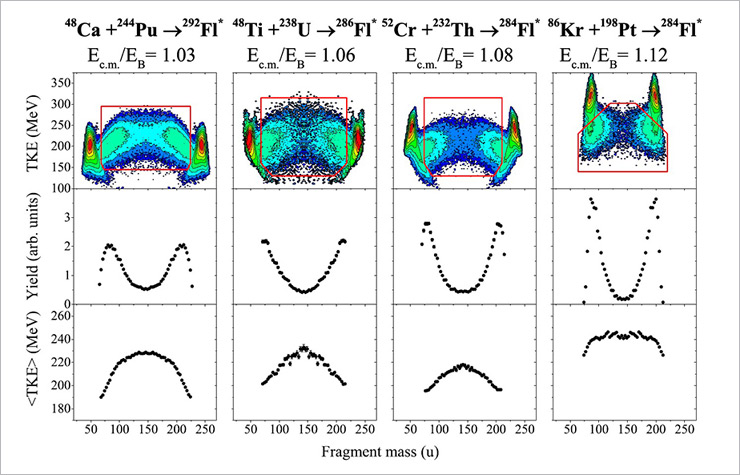 Fig. 3. The mass and energy distributions of binary fragments formed in the reactions 48Ca + 244Pu, 48Ti + 238U, 52Cr + 232Th, and 86Kr + 198Pt leading to the formation of composite systems with Z = 114. From top to bottom: the M-TKE matrices of binary reaction products, the mass distributions, and the average total kinetic energy as a function of mass of fissionlike fragments inside the contour line on M-TKE matrices.
Fig. 3. The mass and energy distributions of binary fragments formed in the reactions 48Ca + 244Pu, 48Ti + 238U, 52Cr + 232Th, and 86Kr + 198Pt leading to the formation of composite systems with Z = 114. From top to bottom: the M-TKE matrices of binary reaction products, the mass distributions, and the average total kinetic energy as a function of mass of fissionlike fragments inside the contour line on M-TKE matrices.
Moreover, we found that the properties of symmetric fragments change significantly at the transition from 48Ca ions to 48,50Ti (Fig. 3) and 52,54Cr (Fig. 2) ions. In the case of 64Ni- and 68Zn-induced reactions (Fig. 2), these changes are drastic. It was shown [6, 8] that at energies above the barrier, the contribution does not change with increasing interaction energy and is about 5–6% for the reactions with 52Cr ions, contrary to the reactions involving actinide nuclei and 48Ca ions, where the contribution of symmetric fragments increases monotonically. This may indicate a significant increase in the quasifission process at the transition from 48Ca to 48Ti and 52Cr ions (Fig. 4). Thus, for the nuclear systems with Z1Z2 > 2000, the quasifission is a dominant process even in the formation of symmetric fragments.
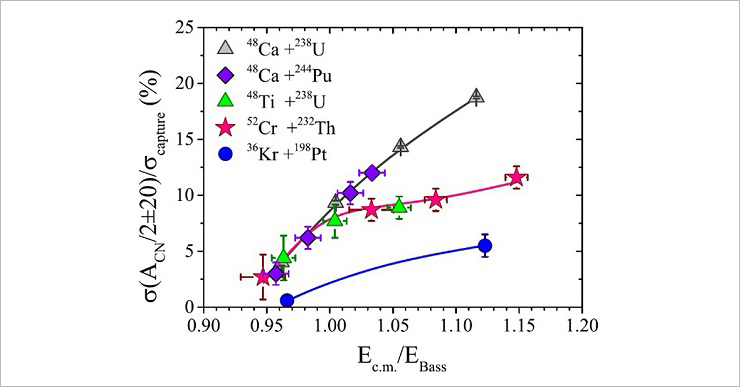 Fig. 4. The contribution of symmetric fragments in all fissionlike events formed in the reactions 48Ca + 238U, 48Ca + 244Pu, 48Ti + 238U, 52Cr + 232Th, and 86Kr + 198Pt in dependence on the interaction energy.
Fig. 4. The contribution of symmetric fragments in all fissionlike events formed in the reactions 48Ca + 238U, 48Ca + 244Pu, 48Ti + 238U, 52Cr + 232Th, and 86Kr + 198Pt in dependence on the interaction energy.
The fusion probabilities for the 52,54Cr + 248Cm and 68Zn + 232Th reactions were estimated in Ref. [6] on the basis of the analysis of mass and TKE distributions. The obtained fusion probabilities are in good agreement with the fusion probability dependence on the mean fissility parameter found for the reactions of well-deformed nuclei with 36S, 48Ca, 48Ti, and 64Ni ions. The fusion probability is found to drop by approximately three orders of magnitude at the transition from 48Ca + 238U to the 54Cr + 248Cm reaction and by more than a factor of 105 to the 68Zn + 232Th reaction. Based on the obtained fusion probability for the 54Cr + 248Cm reaction, the production cross section of superheavy element with Z = 120 is expected to be about a few femtobarns. In the case of the 64Ni + 238U and 68Zn + 232Th reactions the production cross sections are one and two orders of magnitude lower, respectively.
Thus, the complete fusion reactions of Ti and Cr ions with actinides can be used to synthesize new superheavy elements with Z > 118. However, the compound nucleus production cross section in these reactions drops down by several orders of magnitude compared to the reactions with 48Ca ions. Alternatively, these nuclei can be produced in the multinucleon transfer reactions, such as 238U + 238U or 238U + 238Cm, that may be makes it possible to obtain more neutron-rich nuclei than in the case of complete fusion reactions.
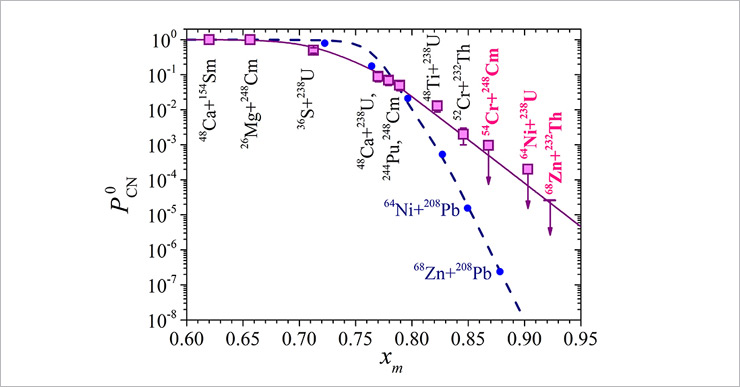 Fig. 5. Fusion probability for the 54Cr + 248Cm and 68Zn + 232Th reactions in comparison with fusion probabilities in hot fusion (with strongly deformed target nuclei) reactions [11] at energies above the Coulomb barrier as a function of the mean fissility parameter of the reaction. The circles denote the calculated fusion probabilities for cold fusion reactions [12].
Fig. 5. Fusion probability for the 54Cr + 248Cm and 68Zn + 232Th reactions in comparison with fusion probabilities in hot fusion (with strongly deformed target nuclei) reactions [11] at energies above the Coulomb barrier as a function of the mean fissility parameter of the reaction. The circles denote the calculated fusion probabilities for cold fusion reactions [12].
To summarize, a wide series of experiments aimed at investigating the probability of formation and decay of superheavy systems in dependence on the Coulomb factor Z1Z2 at energies near the Coulomb barrier has been performed.
For the composite systems with Z = 114 and 120 the properties of fusion-fission and quasifission processes have been analyzed. For the systems with the Coulomb factor Z1Z2 > 2000 the dominant role of quasifission has been confirmed. For all studied reactions the fusion probabilities have been estimated. The obtained results will be useful in future investigations of the “island of stability” and conducting the experiments to synthesize superheavy elements with Z > 118. The scientific team was awarded the first prize for research and experimental work at the 129th Session of JINR Scientific Council.
Candidate of Science, Eduard M. Kozulin,
the Head of Sector №5 Dynamics
of heavy nuclei interaction,
fission of heavy and superheavy nuclei,
FLNP JINR
Bibliography
- Yu. Ts. Oganessian, V. K. Utyonkov, Yu. V. Lobanov et al. Measurements of cross sections and decay properties of the isotopes of elements 112, 114, and 116 produced in the fusion reactions 233,238U,242Pu, and 248Cm+48Ca. Phys. Rev. C 70, 064609 (2004).
- Yu. Ts. Oganessian, V. K. Utyonkov, Yu. V. Lobanov et al. Synthesis of the isotopes of elements 118 and 116 in the 249Cf and 245Cm+48Ca fusion reactions. Phys. Rev. C 74, 044602 (2006).
- Yu. Ts. Oganessian. Heaviest nuclei from 48Ca-induced reactions. J. Phys. G: Nucl. Part. Phys. 34, R165 (2007).
- Yu. Ts. Oganessian, F. Sh. Abdullin, P. D. Bailey et al. Synthesis of a New Element with Atomic Number Z=117. Phys. Rev. Lett. 104, 142502 (2010).
- K. Morita, K. Morimoto, D. Kaji et al. Experiment on the Synthesis of Element 113 in the Reaction 209Bi(70Zn,n)278113. J. Phys. Soc. Jpn. 73, 2593 (2004).
- K. V. Novikov, E. M. Kozulin, G. N. Knyazheva, J. M. Itkis, M. G. Itkis, A. A. Bogachev, I. N. Diatlov, M. Cheralu, D. Kumar, N. I. Kozulina, A. N. Pan, I. V. Pchelincev, I V. Vorobiev, W. H. Trzaska, S. Heinz, H. M. Devaraja, B. Lommel, E. Vardaci, S. Spinosa, A. Di Nitto, A. Pulcini, S. V. Khlebnikov, Pushpendra P. Singh, Rudra N. Sahoo, B. Gall, Z. Asfari, C. Borcea, I. Harca, and D. M. Filipescu, Investigation of fusion probabilities in the reactions with 52,54Cr, 64Ni, and 68Zn ions leading to the formation of Z = 120 superheavy composite systems. Phys. Rev. C 120, 044605 (2020).
- K. V. Novikov, E. M. Kozulin, G. N. Knyazheva, J. M. Itkis, A. V. Karpov, M. G. Itkis, I. N. Diatlov, M. Cheralu, B. Gall, Z. Asfari, N. I. Kozulina, D. Kumar, I. V. Pchelincev, V. N. Loginov, A. E. Bondarchenko, P. P. Singh, I. V. Vorobiev, S. Heinz, W. H. Trzaska, E. Vardaci, N. Tortorelli, C. Borcea, and I. Harca. Formation and decay of the composite system Z = 120 in reactions with heavy ions at energies near the Coulomb barrier. Bull. Russ. Acad. Sci. Phys. 84, 495 (2020).
- E. M. Kozulin, G. N. Knyazheva, T. K. Ghosh, A. Sen, J. M. Itkis, M. G. Itkis, K. V. Novikov, I. N. Diatlov, I. V. Pchelincev, C. Bhattacharya, S. Bhattacharya, K. Banerjee, E. O. Savelyeva, and I. V. Vorobiev. Fission and quasifission of the composite system Z = 114 formed in heavy-ion reactions at energies near the Coulomb barrier, Phys. Rev. C 99, 014616 (2019).
- E. Vardaci, M. G. Itkis, J. M. Itkis, G. Knyazheva, E. M. Kozulin. Fission and quasifission toward the superheavy mass region. J. Phys. G: Nucl. Part. Phys. 46, 103002 (2019).
- E. M. Kozulin, A. A. Bogachev, M. G. Itkis, J. M. Itkis, G. N. Knyazheva, N. A. Kondratiev, L. Krupa, I. V. Pokrovsky, E. V. Prokhorova. The CORSET time-of-flight spectrometer for measuring binary products of nuclear reactions. Nucl. Exp. Tech. 51, 44 (2008).
- E. M. Kozulin, G. N. Knyazheva, K. V. Novikov, J. M. Itkis, M. G. Itkis, S. N. Dmitriev, Yu. Ts. Oganessian, A. A. Bogachev, N. I. Kozulina, I. Harca, W. H. Trzaska, and T. K. Ghosh. Fission and quasifission of composite systems with Z=108−120: Transition from heavy-ion reactions involving S and Ca to Ti and Ni ions. Phys. Rev. C 94, 054613 (2016).
- V. I. Zagrebaev, W. Greiner. Cross sections for the production of superheavy nuclei. Nucl. Phys. A 944, 257 (2015).